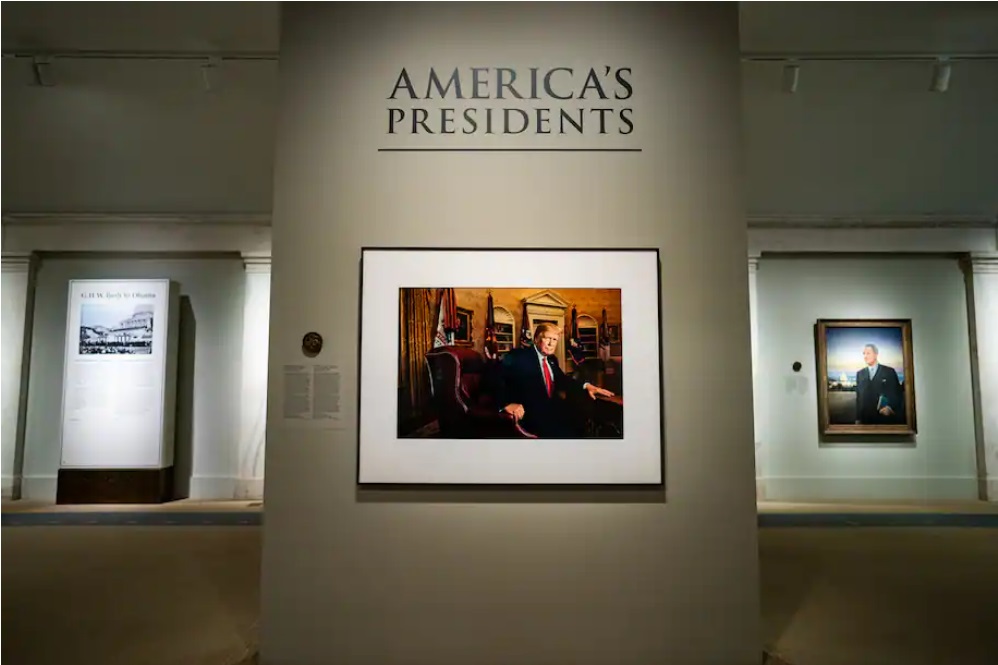Even one-term presidents are remembered in the National Portrait Gallery.
When the National Portrait Gallery reopens May 14, visitors will have the first opportunity to see a President Trump portrait in the popular America’s Presidents exhibition.
Pari Dukovic’s photograph of the former president depicts him seated in the Oval Office behind the Resolute Desk.
It has taken the place of Kehinde Wiley’s portrait of President Barack Obama, which, starting in June, will go on a year-long, five-city tour with Amy Sherald’s painting of former first lady Michelle Obama. Shepard Fairey’s “Hope,” a collage acquired by the gallery in 2008, replaces the Wiley painting.
“There’s always a sense of transition when we install a new presidential portrait,” Dorothy Moss, the gallery’s curator of painting and sculpture, said of the exhibit. “We are a museum that reflects art history and biography, and we are able to celebrate the presidents with portraits that are historical documents.”
The Smithsonian museum has been closed since Nov. 23 because of the coronavirus pandemic, delaying the traditional post-inaugural update to the presidents gallery.
Dukovic took the photograph on June 17, 2019, for Time magazine. It is the newest portrait of Trump in the National Portrait Gallery’s permanent collection, joining four others that predate his presidency, said Leslie Ureña, curator of photographs.
Dukovic’s photograph will be on view while the official Trump portrait is being completed.
The museum is not sharing details of that commission nor on the one of former first lady Melania Trump, except to say that the process is underway.
Dukovic is an award-winning photographer whose portfolio includes portraits and fashion as well as news, sports and entertainment events.
His photograph of Obama graces the cover of the 44th president’s recent memoir, “A Promised Land.”
His portrait of Trump has both artistic and historic merit, Ureña said.
“I like the composition of the photograph,” she said of Dukovic’s image. “It is an angle we don’t often see. You get a little bit of the other side and what’s behind the desk.”
The photograph’s historical details include flags along the wall representing the five branches of the armed forces, a portrait of Andrew Jackson and one of Benjamin Franklin by Joseph Duplessis that the museum loaned to the White House.
These reflect Trump’s interests and influences, Ureña said.
The photograph was taken the day before Trump officially announced he would seek reelection, adding to its historical value, Ureña said.
“We want to not only depict the individual,” she said, “but also bring as much history as much context as possible.”
That context is found in the wall text, the brief biography that sums up each president’s tenure.
Trump’s achievements include record low unemployment, restrictions on immigration and the appointment of “a record number of federal judges, including three Supreme Court Justices,” the summation says.
It also notes that he was twice impeached and twice acquitted, and ends with this: “The beginning of the coronavirus pandemic (COVID-19), which resulted in a devastating loss of human lives and an economic crisis, became a key issue during his reelection campaign.
More Americans voted in the 2020 presidential election than ever before, and the majority elected Joe Biden.
Nevertheless, Trump did not concede, and a mob of his supporters, who refused to accept the results, attacked the U.S. Capitol complex on January 6, 2021, when Congress was working to certify Biden’s win.”
The exhibition’s approach of offering historical analyses instead of hall of fame citations is applied to all of the presidential portraits, Moss noted.
The Nobel Peace Prizes won by Theodore Roosevelt, Woodrow Wilson and Barack Obama are not included in their wall texts, while George W. Bush’s failure to win the popular vote in 2000 is.
The museum notes that Wilson “is most often remembered as a champion of liberal values, but recent scrutiny has drawn attention to his regressive actions with regard to women’s voting rights and segregation in the government, as well as other violations of civil rights.”
Similarly, it says that Bill Clinton’s “second term was marked by several scandals, including lying while under oath about a sexual relationship he had with a White House intern. For this, he was impeached by the House of Representatives but was not convicted in the Senate trial.”
“We’re looking at the American presidency in its entirety. We do include critical comments, but we’re even in our assessments,” Moss said, adding that these reflections are written by the museum’s curators and historians. “It’s a process of collaboration. A lot of people review it. There’s a lot of discussion.”
This article originally appeared in The Washington Post.
